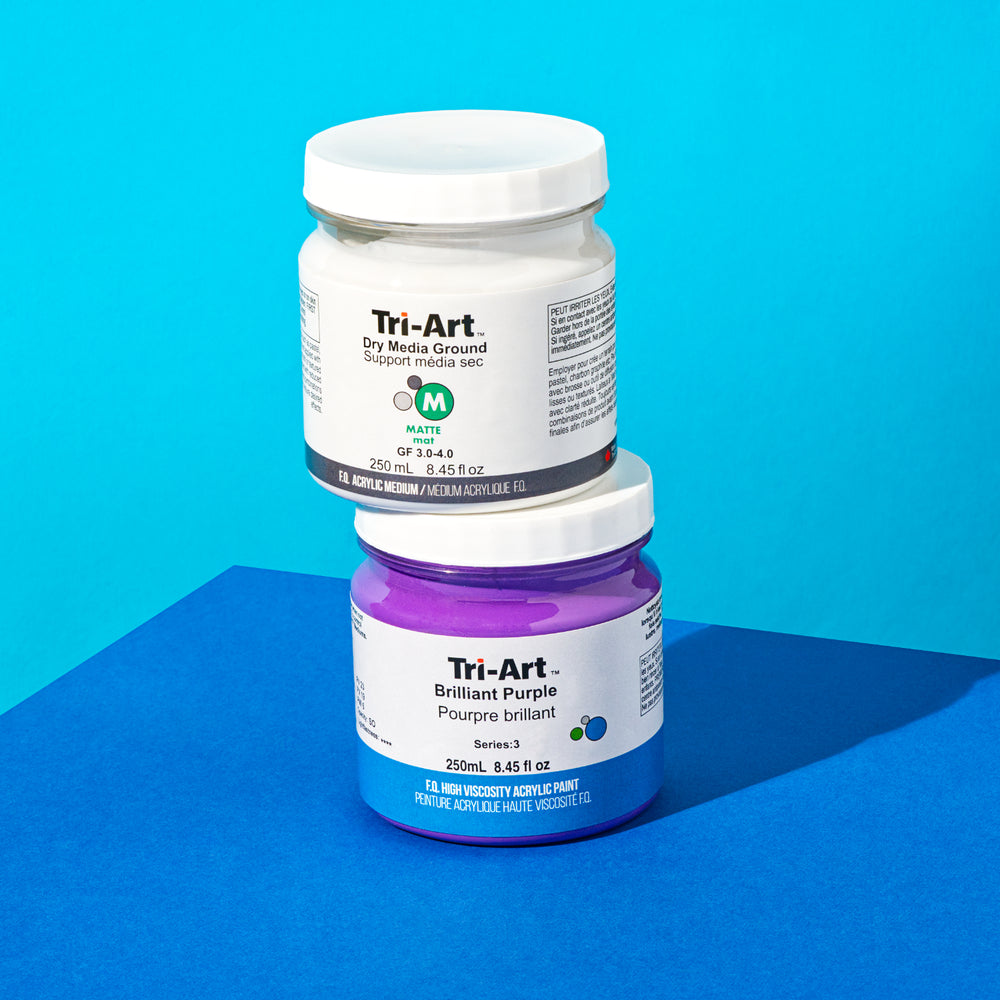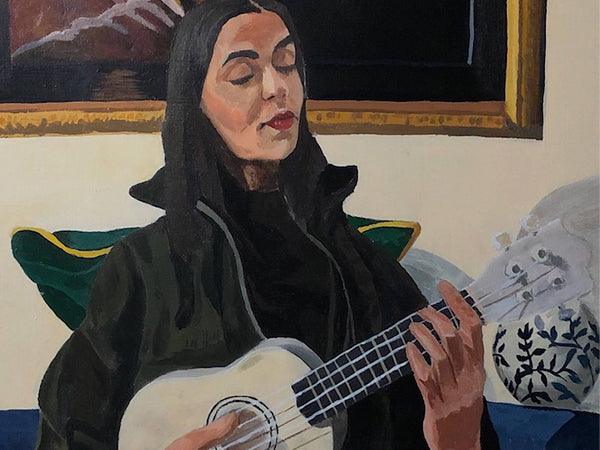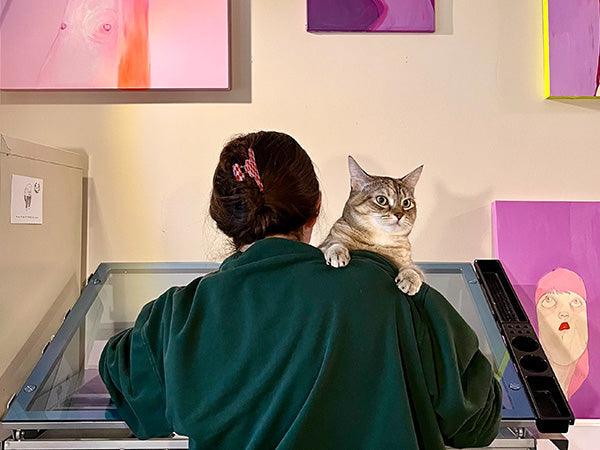
"We're responding to things that are happening today and we're creating kind of as a hivemind."
Inspiration and Influence: Who are some of your greatest creative inspirations? How do they influence the tone of your work?
Who were some of your greatest creative inspirations?
When I reflect on artists who I've always admired – Maud Lewis is top tier for me. Maud, as you probably know, is an artist from Nova Scotia that lived with rheumatoid arthritis, but she's kind of known for her love of decorating the spaces that she lived in.
I love the very confident, carefree folk art; colourful and simple shapes capturing daily life. I admire Maud as a human as well – being able to find joy despite having a lot of hardship.
There's not a lot of greats that I look up to, but am really motivated by many of my peers and pals. Like Gillian Wilson, Caro Benitez, Yvonne Weiss…these are all artists who are using botanicals in really contemporary ways and work across mediums. Also, Jill Glatt is an amazing local printmaker and textile artist, and I love how she uses her art as an activism. My friend Caro is a botanist and has a lot of love and care for representing plants accurately.
I think our peers fuel art within the greater sense of community and it is really powerful. We don't make art in a vacuum. We're responding to things that are happening today and we're creating as a hivemind.


Early Life: When did you realize you were an artist and how did you come to that realization?
Early Life: When did you realize you were an artist and how did you come to that realization?
My parents had me when they were really young – my mom was pregnant with me when she was in high school. Growing up with really young parents that didn’t have a lot of money, well, art was a very accessible and affordable pastime to occupy my mind. I have a lot of really fond memories of just being handed colours in the form of markers, paints, or pencil crayons and just drawing on newspaper articles, adding to pictures in my own way. There was no pressure.
Also, my mom didn't really hold on to artwork. My work wasn't framed on the fridge or anything. It was just something I did, a creative skill to sharpen that wasn’t necessarily about the finished product. I feel like as we grow up, some people don't want to scribble anymore, and others want to keep mark making throughout their life.
I have a strong belief that we are all artists. When we are born and when we grow into children we use mark making to express ourselves. Be it through storytelling, imagination, or observation – these are all skills that we are born with. I think later in life there comes a moment where you're like, “well, maybe I'm not the best at this” and you stop practicing, you stop being inspired by that. I really think being an artist is not an occupation or a career path. I don't think it's necessarily a job. I think it is a role in society; it's a way of thinking. A lot of what it boils down to is communicating and standing for something.
Being an artist has nothing to do with capitalism at first as well. You can be a painter who makes money from your paintings but that is separate from identifying as an artist, which can be so liberating.


Personal Significance of Art: What does creating art mean to you on a personal level, and how has it impacted your life?
I identify as queer and I feel like seeing representation was really important in my own personal journey and the uncovering of my identity. I think that is relevant for everyone; the truth that representation matters, be it in cinema, music, visual arts, or in books… etc. Hearing stories from people who you feel similar to is super impactful – especially coming from a small town like myself who grew up in a rural community in Perth, Ontario. There’s not a lot of queer folks. There's not a lot of BIPOC people. It still has pockets of really progressive thinkers but it may not be modeled at the leadership level. So, as a young kid growing up, going to national galleries and seeing activist art or learning about artists who are outside of the canon of art history was powerful. Being exposed to those things gave me the ability to see what my life could be if I was out. It was like “okay, there are other people who are queer and who do have happiness”.
Representation offers you the ability to be proud of who you are. That gives me hope.

"Hearing stories from people who you feel similar to is super impactful – especially coming from a small town."

Integrating Growth into Art: As you've grown personally and professionally, how have these changes manifested in your art? Can you describe how a recent work reflects a new stage or development in your life or artistic perspective?
Art is a reflection of who we are so it makes sense that someone's art would evolve with them as they grow as a person. I am no exception to that. I think back to the art I was making when I was in university. Back then was the first time I was working through some past trauma. My work in response was heavy, and since I was not equipped to process these emotions, it was all very raw. It was very expressive, you know, a lot of big, bold gestures, and darker colours. I've grown to be where I am now because I took the time to process those feelings and emotions and digest what happened; through art making and therapy I was able to acknowledge my truth and then move forward in my life. Nowadays I'm pretty proud of how far I’ve come and so I use humour a lot more in my work.
I still tackle bigger issues like gay and trans rights, radical consent, and I still talk about gendered violence in my work, but I feel like humour and play can be a very impactful tool to invite more people into the conversation.

Motivation Behind Creation: What drives you to create art? Is there a core motivation or theme that underpins all your work?
This current stage of my art making seems to be about resilience and liberation. I also think genuine friendship has been a huge motivator, you know? And friendship in terms of intimate conversations and sharing closely. I work as a tattoo artist and appreciate the bond we get to make with strangers. All of those conversations are vulnerable and really fuel my practice – be it tattooing, printmaking, or illustration. I feel like learning from each other is super vital for succeeding as a society. Listening to each other is huge.

"We are change makers, thinkers, and we can fight for resources from and for our communities."
Balancing Creativity and Productivity: Many artists feel pressure to be consistently productive. How do you balance the need for creative expression with the pressures of producing work regularly?
I was talking with a young artist recently about how they were feeling like they have to play into capitalism to make their art survive. I advocated for them to think outside of capitalism. My thinking is that this stressful competition is a result of a lack of resources within a community to support artist projects. It's good to acknowledge that capitalism exists and our society follows it’s lead, but also I think we need to consistently remember that artists are not factories. We are not companies. We are change makers, thinkers, and we can fight for resources from and for our communities. One of the ways to combat these structures is through collaboration. Collaborating is such a valuable tool.
Also, if you need to take a break from making art that doesn't mean you're not an artist for that amount of time. You get to take space away from making art. You get to let go of that expectation. There are so many other ways to be creative when you're not making physical visual art; like cooking meals for your loved ones, winterizing the chicken coop, or volunteering your time and skills. Using our bodies, and our minds, and our hands are all valid things for us as artists to continue to do to fuel our practice AND fuel our wellbeing.

Activism Through Art: How do you integrate activism into your artwork, and why is it important for you to address social or political issues through your creations?
I am an artist and activist, so these two things kind of merge into one often. I could be wrong, but I feel like a lot of times, as artists, we are an extension of our beliefs and values. I mean, there is no such thing as neutrality.
I often try to use my skills in being able to make “pretty things” to grab people's attention. Like I may draw a really pretty picture of a flower and use text within that visual to express a statement or a movement that I feel is important and meaningful. I think alongside that perhaps selling prints or designing specific flash sheets to raise money for causes I believe in, like the Indigenious Women Rising abortion fund. If I can offer a visual gift in exchange for that donation that is really neat to me. I know a lot of artists volunteer their artist skills to non-profits who maybe don't have huge budgets to make really interesting visuals.


Community Engagement: How does your art engage with or reflect the communities you are a part of? How important is this connection to you?

We have a super duper exciting exhibition happening now that is very community centered. It’s at the Agnes Etherington Art Centre and is curated by Charlotte Gagnier. It’s called we are magic: a love letter to our tattoos.
I’m operating out of the space every Friday as a tattoo artist. We have temporary tattoos that people can come and get as well if tattoos aren't for them. There's also a little making station where people can come and dream up flash tattoos. I love tattoos, obviously. Tattoos are a form of shape shifting, and they have the capacity to tell stories and allow us to daydream about better futures. In their core essence, tattoos are a form of reclaiming your identity. Also, we touched on the importance of listening to each other in our community.
Like I said, when I was making art in university it was really for me, but now I want to bring people in and actually sit down and talk about these things. My work has shifted to include more voices. I really value the potential that art has as a coping mechanism – or perhaps a better term might be a healing mechanism. I value the representation and the communities I’ve been welcomed into and also the communities I have helped nurture with my art.




